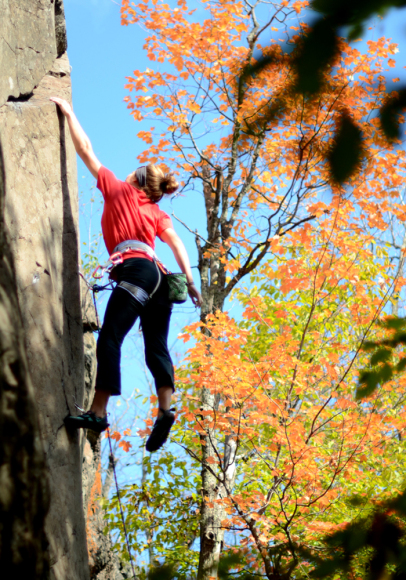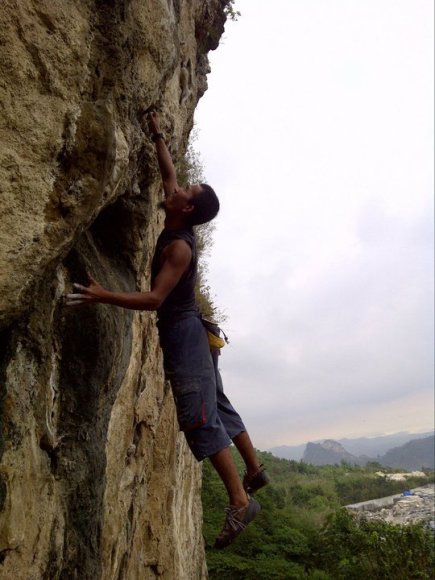Pressure
Pressure, is defined as P=F/A this in turn translates
to pressure equals mass times acceleration divided by a
surface area. in climbing the masses and acceleration are
incredibly high for the total area. take the gentleman in
the picture above for example he is essentially holding on
with one hand. his feet are not touching the wall and his
other hand is only helping him to balance, looking at size
and build we can guess that he is about 160 pounds. Which
in turn converts to about 73 kilograms.for our example we
will say that acceleration due to gravity is 10 meters per
second squared (instead of its actual 9.8m/s^2). we don't
really have a way of telling the surface area that his
hand covers so instead we will use an average for a male
hand. this turns out to be about 12600 square mm which
translates to approximately .0126 square meters.
 So to get pressure we now just plug in the numbers,
Pressure = 73kg x 10m/s^2 / 0.0126m^2 this comes out to
be 57937 newtons per square meters. This number is
fairly large, and in climbing it can get much larger.
when you consider that all the pressure that is being
put on the rock you have to think about what is
translating back to the climbers joints, tendons and
muscles. the stress that gets put on the joints is
sometimes tremendous. this in turn causes some
climbers to pop there pulley joints in there fingers or to
rip right though the tendons in there arms. this is mostly
known to happen when a climber is using a mono pocket (a
very small hole in a rock surface that you can only fit
one finger in) or when using very small crimps to stay on
the wall.(crimps being hold that have almost nothing to
hold onto, so you can only get the very tips of your
fingers on them) For instance lets say that our
climber from earlier was supporting his weight on the use
of one mono pocket. this is something that some climbers
can do, although it is known to be quite hard. the only
thing that changes from our original equation is the
surface area, because now instead of supporting himself
with one hand he is doing it with a single finger
tip. So we have pressure = 73kg x 10m/s^2 /
.00048 m^2 now the pressure that is caused by the climber
onto the rock and in turn translates back to the climber
is 1520833 newtons/m^2. hopefully you can see how large
that is, and more importantly how important it is to think
about pressure and such when you are climbing, it could
help keep you from injury.
So to get pressure we now just plug in the numbers,
Pressure = 73kg x 10m/s^2 / 0.0126m^2 this comes out to
be 57937 newtons per square meters. This number is
fairly large, and in climbing it can get much larger.
when you consider that all the pressure that is being
put on the rock you have to think about what is
translating back to the climbers joints, tendons and
muscles. the stress that gets put on the joints is
sometimes tremendous. this in turn causes some
climbers to pop there pulley joints in there fingers or to
rip right though the tendons in there arms. this is mostly
known to happen when a climber is using a mono pocket (a
very small hole in a rock surface that you can only fit
one finger in) or when using very small crimps to stay on
the wall.(crimps being hold that have almost nothing to
hold onto, so you can only get the very tips of your
fingers on them) For instance lets say that our
climber from earlier was supporting his weight on the use
of one mono pocket. this is something that some climbers
can do, although it is known to be quite hard. the only
thing that changes from our original equation is the
surface area, because now instead of supporting himself
with one hand he is doing it with a single finger
tip. So we have pressure = 73kg x 10m/s^2 /
.00048 m^2 now the pressure that is caused by the climber
onto the rock and in turn translates back to the climber
is 1520833 newtons/m^2. hopefully you can see how large
that is, and more importantly how important it is to think
about pressure and such when you are climbing, it could
help keep you from injury.
